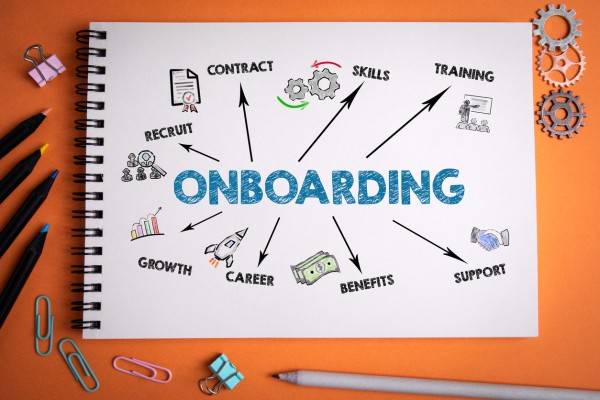The onboarding process involves introducing new employees to the organization’s culture, policies, values, and work processes. It provides new hires with the necessary information and tools to be productive and successful in their new role.
The onboarding process can be overwhelming and intimidating, making it challenging for new employees to adjust and fit in. The onboarding checklist sets the foundation for a fruitful relationship between employer and employee. A seamless onboarding experience can help new hires feel welcomed and valued, boosting their engagement and retention.
To get onboarding on track and ensure a successful onboarding experience, an onboarding checklist covering all necessary steps is essential. In this blog post, we’ll delve into employee onboarding best practices, such as tips for creating a practical onboarding checklist, innovative ways to enhance the new hire experience, and the numerous benefits of a comprehensive onboarding program.
By following these best practices, HRs can establish a harmonious work culture that will improve employee satisfaction and ultimately lead to business success. Join us as we discover how to create a memorable onboarding experience for your new team members. This has broken into five phases for easy comprehension:
The significance of a positive onboarding experience
1: The importance of employee onboarding
We must understand the usefulness of employee onboarding as it is vital for any organization. A successful onboarding program can help new employees acclimate to the company culture and work processes, increasing engagement and retention.
Conversely, a poor onboarding experience can adversely affect the company, such as decreased employee satisfaction, low productivity, and a high turnover rate, negatively impacting the company’s image.
The role of onboarding in employee retention and engagement
According to Glassdoor onboarding statistics, organizations with a vital onboarding process improve new employee retention by 82% and productivity by over 70%. Employees who undergo a systematic onboarding program are more likely to stay with the organization longer and be more productive.
A successful onboarding process can help new employees understand the company’s culture, vision, and mission, giving them a sense of belonging to the new team. This, in turn, leads to increased employee engagement, which has been shown to improve performance, job satisfaction, and overall well-being.
The costs of poor onboarding and the impact on the company
A poor onboarding experience can have high costs for the company. According to a Society for Human Resource Management (SHRM) study, companies with poor onboarding programs experience higher turnover rates, lower employee engagement, and reduced productivity.
A bad onboarding experience can lead to negative reviews on websites like Glassdoor, discouraging top talent from applying to the company. Poor onboarding can equally have financial implications.
The cost of replacing talent in a company is estimated to be 50-200% of the employee’s annual salary. If an employee earning $50,000 per year leaves the company, it could cost the company between $25,000 and $100,000 to replace them.
The benefits of a successful onboarding program
A successful onboarding program can bring many benefits to the organization, such as;
- Increased productivity,
- Reduced turnover, and
- Improved employee satisfaction.
A comprehensive onboarding program can help new hires understand the company’s culture, values, and expectations, making them feel more connected to the company.
Moreover, an effective onboarding program can accelerate productivity, helping new employees contribute more quickly to the company’s goals and objectives. This, in turn, can lead to increased revenue and growth for the organization.

2. Creating an effective onboarding checklist
A successful onboarding process starts with a comprehensive onboarding checklist. The checklist should cover all necessary steps, from filling out paperwork to training programs and company policies. Here are some tips for creating a practical onboarding checklist:
- Start with the basics: The onboarding checklist should include essential items such as filling out paperwork, signing contracts, and getting familiar with the company’s policies and procedures.
- Personalize the checklist: New hires come with different needs and skill sets. Personalizing the onboarding checklist to fit the new hire’s role and needs can help them feel more connected to the organization. For instance, if the new hire is a software engineer, their checklist should include technical training programs and access to the necessary tools.
- Be clear and concise: The onboarding checklist should be clear and concise, with detailed instructions on what the new hire needs to do and by when. The checklist should also provide contact information for HR personnel or managers who can answer any questions.
- Use technology: Using technology can streamline the onboarding process and make it more efficient. For example, using an online portal to fill out the paperwork can save time and reduce errors. Similarly, using online.
Learn about Simpplr employee onboarding solutions
- Promote inclusiveness: Ensuring the onboarding program is inclusive and promotes diversity, equity, and inclusion (DEI) is crucial. Inclusiveness can be achieved by incorporating DEI training and education into the onboarding process, providing opportunities for new hires to connect with employee resource groups, and creating a culture of respect and inclusivity within the company.
A strong focus on DEI in onboarding can help attract diverse talent, increase employee engagement and retention, and foster a more positive and supportive workplace culture.
- Provide clear expectations: The hiring manager is crucial in setting new hires up for success by providing clear expectations, regular employee feedback, and ongoing support. It’s essential for hiring managers to be involved in the onboarding process, welcome new hires, give an overview of the team’s goals and responsibilities, and check in regularly to provide guidance and support.
Providing training and resources to hiring managers can also help them to be more effective in their role and ensure that the onboarding process is a positive and successful experience for new hires.
- Prepare to adapt: Adapting the onboarding program to changing circumstances, such as remote work or changes in the company’s structure or culture, is crucial. By staying flexible and responsive to the needs of new hires and the company, a company can create an onboarding program that sets new hires up for success and promotes a positive and engaged workplace culture.
3. Enhancing the new hire experience
A positive onboarding experience can help new employees feel welcome, valued, and engaged. To enhance the unique hire experience, organizations can start by preparing for their arrival, creating a welcoming atmosphere, and providing necessary information and training. Also, facilitating social integration and networking, assigning a mentor or buddy, setting expectations and goals, and providing regular feedback and support.
Innovative ways to welcome new hires
When new hires join the company, it’s essential to make them feel welcome and valued. A warm welcome can go a long way in creating a positive first impression and setting the tone for the remaining onboarding process. Here are some innovative ways to welcome new hires:
- Virtual tours: If your company works remotely, showing new hires around the office can be challenging. A virtual tour can give them a sense of the workspace, where the restrooms are located, and other essential aspects of the office.
- Welcome videos: A welcome video from the CEO or other leaders in the company can be a great way to introduce new hires to the company’s culture, values, and mission. The video can include a message of welcome, a tour of the office, and an overview of the company’s history and goals.
- Personalized gifts: A small gift or token of appreciation can make new hires feel valued and appreciated. It doesn’t have to be expensive, just something that shows you’re glad to have them on board.
Introducing new hires to company culture and values
Introducing new hires to the company culture and values is essential in early onboarding. This will help them understand what the company stands for and what’s expected of them as employees. Here are some ways to do this:
- Team-building activities: Team-building activities can be a great way to get new hires to interact with their colleagues and learn about the company’s culture. Activities can include group lunches, team-building exercises, or even off-site retreats.
- Mentorship programs: Pairing new hires with mentors can help them adjust to the company’s culture and work processes. Mentors can guide, answer questions, and offer support throughout onboarding.
- Open communication: Encouraging new hires to ask questions and provide feedback can help them feel more comfortable in their new role. Creating an available communication channel can help new hires feel more included and valued.

4. Implementing a comprehensive onboarding program
Implementation starts with understanding, creating expectations, and judiciously crafting timeline-based activities to make the new employee feel at home. A good onboarding experience is crucial, but certain things must always be included.
The Importance of having a structured onboarding program
While ensuring a successful onboarding process, it’s essential to have a structured onboarding program that covers all aspects of the new hire experience. This process includes everything from paperwork to training to team building. A structured program can help new hires feel more comfortable and confident in their new role.
13 steps to onboarding best practice
To attain a brilliant and positive start from new talents upon hire, it is paramount that hiring managers factor certain things into the onboarding program. Here are employee onboarding best practices for a successful hiring process to boost the company’s culture:
1. Pre-board new hires: The Hiring Manager should make provisions for employees before they arrive. It can energize them for their new job and increase their eagerness to participate before the start date.
This is an excellent time for the brand to send them a company souvenir, such as a customized water bottle or notepad with the company’s brand identity, to encourage them as we give a nice perfection, spark curiosity, and induce familiarity with asking questions.
Also, it is paramount for HR to send them an email with the onboarding schedule, so they know what to expect from day one.
2. Paperwork: It’s a great idea to offer a new employee a head start on basic onboarding tasks, such as creating a personalized company email address and finishing HR paperwork, so that their first day doesn’t revolve around filling out documents.
The goal of onboarding documents is for new employees to read and comprehend the terms and responsibilities of their unique position within the company. They are usually both legally and contractually required.
Some examples of paperwork to encourage them to work on before they start include:
- Tax forms – walking them through the EIN, I-9, W-4, and state withholding forms will save both the employee and employer from governmental legal suits. These tax documents apply to employees rather thanindependent contractors. Companies rarely withhold taxes from contractors, but it is always required of employees.
- Direct deposit forms – A natural deposit authorization form allows a third party, typically an employer for payroll, to deposit funds into a bank account. An employer requesting authorization generally requires a voided check to verify the account’s validity.
- Non-compete or non-disclosure agreements – A non-disclosure agreement (NDA), as opposed to non-compete deals, is a contract that is enforceable under the law and creates a confidential relationship. The new employee will not disclose any sensitive information they may obtain to third parties.
- Employee handbook acknowledgment forms
There should be flexibility in how the new employees complete these forms electronically to save them the hassle of printing and filling them out manually.
3. Welcome package: The HR Manager is to walk the new employee through the workspace or station and, if it happens to be a remote role or even hybrid, gift them a customized card, tools such as new laptops, or perks attached to the position.
A welcome package doesn’t necessarily translate to gifts but packages that would give the new hire a sense of belonging as well as aid their workflow.
4. Get teams involved with a holistic integration approach: A successful onboarding process involves all team members. New employees can feel welcomed and integrated into the company culture by including employees, supervisors, and senior leaders. Optimizing the onboarding process with a cohesive, cross-functional effort saves much stress and misinformation.
This process will also help guide the new hire and keep them informed of the ranks; activities also help define and boost human relations.

5. Assign mentors: Accelerating Integration and Networking: A well-structured onboarding process involves more than just paperwork and training. By assigning a mentor to new hires, companies can provide a powerful tool to facilitate their integration and success.
Mentors can guide, support and encourage new employees, helping them navigate company culture and job duties efficiently. This translates into greater employee satisfaction, increased retention rates, and overall business success.
Beyond job training, mentors can share valuable knowledge and insights and offer a personalized, human touch to the onboarding process. Don’t overlook the power of mentoring – it could be the secret to unlocking your company’s true potential.
6. Push for job shadowing: Job shadowing is a best practice in employee onboarding that involves pairing a new hire with a current employee in the same or similar role. The new hire observes the current employee in action, gaining firsthand knowledge of the position and the company’s processes.
Shadowing allows the new employee to learn by example and ask questions in real-time, increasing their understanding and confidence. Job shadowing also promotes relationship building and collaboration among team members, fostering a more positive company culture. Incorporating job shadowing in your onboarding process can enhance the new employee’s experience and lead to a more successful transition into their role.
7. Introduce work gradually: By easing new employees into their roles, they have time to acclimate to the company culture and their responsibilities, reducing the likelihood of mistakes and burnout. Gradual work introduction also allows for ongoing feedback and support, helping new hires adjust to the job and build confidence in their skills.
This approach improves the new employee’s experience and can benefit the company, leading to more productive, engaged, and committed employees. By taking a gradual approach to work introduction, you can set your new hires up for success from day one.
8. Live and breathe employer brand: Training and reiterating company culture happens here. In employee onboarding, it’s crucial to reiterate the company’s culture and values to new hires. By emphasizing the employer brand, companies can ensure new employees understand the expectations and behaviors contributing to the company’s success.
Incorporating the mindset early enough helps to foster a positive company culture where employees feel engaged, motivated, and aligned with the company’s mission. Incorporating the employer brand into onboarding can also improve retention rates and attract top talent who share the same values.
Providing necessary information and training is a critical part of successful employee onboarding. New employees need to learn about the company culture, policies, and procedures and receive the tools and training they need to perform their job effectively.
Training helps them feel prepared and confident in their new role and can lead to increased job satisfaction and retention. By living and breathing the employer brand, companies can build a strong foundation for employee success and long-term growth.
9. Schedule probation checks: Scheduling probation checks is a critical best practice in employee onboarding. These check-ins allow employers to assess the new employee’s progress, provide feedback, and identify areas for improvement. They also allow the new employee to voice any concerns or ask questions.
By having regular probation checks, companies can support their new hires through their transition period and ensure they meet expectations. This approach can reduce turnover, increase employee retention rates, and provide a positive onboarding experience for the new hire. Make scheduling probation checks a priority in your onboarding process for optimal success.
10. Track progress: Tracking progress is a critical element of successful employee onboarding. It allows employers to monitor new hires’ strengths and weaknesses, provide feedback, and adjust the onboarding plan accordingly. Regular check-ins and goal-setting keep new hires engaged, motivated, and invested.
Tracking progress also helps new hires feel a sense of accomplishment as they meet their objectives, which improves overall performance and retention rates. Ultimately, monitoring progress is essential to ensuring that new hires are on the path to success and can contribute positively to the company.

11. Inspire and celebrate wins: By recognizing and celebrating small milestones and achievements, companies can build employee confidence, promote positive company culture, and improve retention rates. Celebrations can take many forms, from recognizing accomplishments at team meetings to offering rewards, anniversaries, or incentives.
These experiences can create a positive workplace environment, fostering a sense of teamwork, collaboration, and motivation. By inspiring and celebrating wins, companies can show new hires they are valued, supported, and an integral part of the team.
12. Conduct feedback surveys: Conducting feedback surveys is not just a nice-to-have; it’s a must-have. You can’t improve what you don’t measure, and feedback surveys are an excellent way to measure the success of your onboarding process. Giving new hires a voice demonstrates that you value their opinions and are committed to creating a positive work environment.
Feedback surveys also provide insights into what new hires want and need, leading to increased engagement, satisfaction, and retention rates. So, don’t be afraid to ask for feedback – your new hires will thank you!
13. Continuous optimization: Continuous optimization is ongoing improvement involving reviewing and refining systems, processes, or products to make them more efficient, effective, and aligned with changing needs and goals.
This approach involves gathering data and feedback, analyzing performance, identifying areas for improvement, testing and implementing changes, and measuring results to see if the changes have had the desired effect. Continuous optimization can help organizations stay competitive, adapt to changing market conditions, and improve overall performance and customer satisfaction.
The role of technology in streamlining the onboarding process
Technology can be crucial in streamlining the onboarding process and making it more efficient. Here are some ways HR can use technology:
- Digital paperwork: Using digital paperwork can save time and reduce the amount of paper used in the onboarding process.
- Online training: Online training can be a more convenient and cost-effective way to train new hires.
- Onboarding software: Onboarding software can help automate the onboarding process and provide a more streamlined experience for new hires. Tools like Gusto, BambooHR, Talmundo, Lessonly, etc., are helpful in this situation.
5. Measuring the success of the onboarding program
Measuring the success of the onboarding program is vital to ensure that it achieves its intended outcomes. Measuring involves setting clear objectives and performance metrics, collecting data and feedback from new hires and their managers, analyzing the results, and making data-driven improvements to the program as needed.
Key indicators of a successful onboarding program can include increased employee engagement, improved job performance and productivity, and higher employee retention rates. Regularly reviewing and refining the onboarding program based on data and feedback can help organizations optimize the process and achieve better outcomes for new hires and the organization.
Track success via key performance indicators (KPIs)
To measure the success of the onboarding process, here are indicators (KPIs) to track:
- Time to productivity: Measure how long new hires can become productive.
- Employee engagement: Survey new hires to measure theirengagement and satisfaction with onboarding.
- Turnover rate: Track the turnover rate of new hires to determine if the onboarding process effectively retains employees.
- Feedback from new hires and managers: Solicit feedback from new hires and their managers to identify areas for improvement and make adjustments to the onboarding program.
- Performance metrics: Monitor the performance of new hires to determine if the onboarding program is effectively preparing them for their role and setting them up for success.
- Retention rate: Track the retention rate of new hires to determine if the onboarding program effectively retains employees and reduces turnover.
By measuring these KPIs and regularly evaluating the onboarding program, companies can make data-driven decisions to improve the program and ensure that new hires are successful and engaged in their roles.
Conclusion
Effective employee onboarding is essential for organizations that want to attract, engage, and retain top talent. By designing a comprehensive onboarding program that prepares, welcomes, trains, and supports new employees.
Organizations can set their new hires up for success, build stronger relationships, and ultimately increase employee retention and productivity. However, it’s not enough to create an onboarding program; it’s essential to continually review and optimize the process based on feedback and data.
Do you want to learn more about improving your organization’s employee onboarding program? We invite you to request a demo from Simpplr to see how our solutions can help you enhance the new hire experience and achieve better outcomes!















